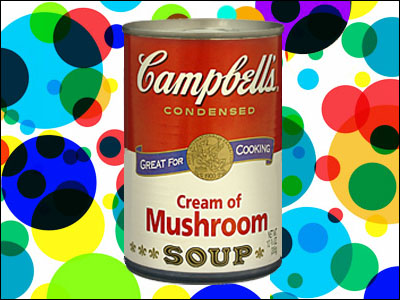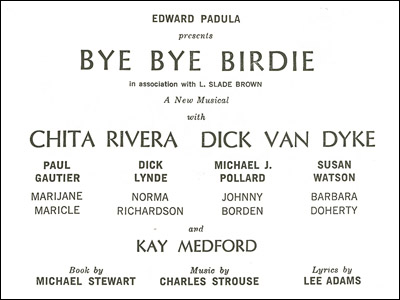
Way too much to deal with today. Will post later if I can. In the meantime, there are plenty of other things to read on the web, most of which have the word "indictment" in them.

Way too much to deal with today. Will post later if I can. In the meantime, there are plenty of other things to read on the web, most of which have the word "indictment" in them.
Randy Rainbow…
This is from The Ed Sullivan Show for Sunday evening, November 13, 1960. It's Dick Van Dyke performing the number "Put on a Happy Face" from the then-running Broadway show, Bye Bye Birdie. If you're only familiar with the movie version of the show, you may be puzzled by the context. The book was heavily rewritten when it was made into a movie.
On stage, Albert Petersen (Van Dyke's character) was an aspiring English teacher who was writing songs for Elvis Presley Conrad Birdie and who hoped to get another song recorded by Birdie and on the Hit Parade charts before the recently-drafted singer went into the army. The happy ending [SPOILER ALERT!] is that Albert gives up songwriting, marries his long-waiting fiancée Rosie and they move to a small town so he can become an English teacher.
The movie inserted most (not all) of the songs into a new storyline. Albert was a biochemist who was pursuing songwriting to make money and to keep a promise to his mother. There was a weird subplot involving Russians along with ballet dancers and tortoises on speed and the happy ending this time is [SPOILER ALERT!] that Albert gives up songwriting, marries his long-waiting fiancée Rosie and they move to a small town so he can pursue his biochemistry.
That's why in this clip, he sings the song to a morose Conrad Birdie fan instead of to the woman he's going to marry. By the way, the script for the film was written by Irving Brecher, who also wrote At the Circus and Go West for the Marx Brothers.

Some interesting dates: Bye Bye Birdie opened on Broadway on April 14, 1960. Business was probably sagging a bit by November, which is why the cast was doing numbers from it on Ed's show.
Dick took a week off in January of 1961 to fly to Hollywood and film the pilot for The Dick Van Dyke Show. His replacement for that week was Charles Nelson Reilly, who ordinarily played the role of Mr. Henkle in the show except on most Thursday nights when he filled in for Paul Lynde, who was playing Harry McAfee. Lynde had a contract to appear every week (live) on Perry Como's TV show. Whenever Reilly was playing Albert or Harry, a cast member named Lee Howard played Mr. Henkle and also covered Harry when necessary.
I once heard Dick Van Dyke tell a very funny story about returning from California. He got back too late to do that evening's performance but not too late to get a seat in the audience and watch it with Reilly playing Albert. And then Dick did a very funny impression of C.N.R. trying to ad-lib his way through songs for which he did not know the lyrics. This one went: "Ya-da-da-da-da-da-da, put on a happy face…Ya-da-da-da-da-da-da, put on a happy face…" Here's how it was supposed to go…
The show finally closed on October 17, 1961, two weeks after The Dick Van Dyke Show debuted on CBS. The Broadway run was 607 performances but Van Dyke and Chita Rivera (the original Rosie) left after April 8, 1961 and were replaced by Gene Rayburn (yes, the game show host) and Gretchen Wyler.
But "Put on a Happy Face" long outlived the show. It was recorded by dozens of top recording artists and it even became the theme song for the TV series, The Hollywood Palace where it sounded like this…
I probably shouldn't be surprised by this but there are an awful lot of people on the web and the news who are absolutely, 100% certain that Donald Trump is innocent and an awful lot who are sure he's guilty. And none of them felt they ought to wait and hear exactly what he's being charged with before they locked into those opinions.

Another damned obit. Duane Poole, a fine writer and gentleman, passed away this evening following a battle with cancer over the last year or so. I knew Duane as an animation writer, mostly at Hanna-Barbera but also at other studios, but he also wrote dozens of live-action TV shows and movies and was both a playwright and an important figure in local theater. When we had lunch, we usually talked about plays and musicals, and he knew everything about them.
Between around 1975 and 1983, Duane (usually with a partner) wrote for all the major shows at H-B including Scooby Doo, Laff-a-Lympics, Captain Caveman, Super Friends, Jana of the Jungle and The Great Grape Ape. During that period, he also worked for Sid & Marty Krofft on shows like The Far-Out Space Nuts and ElectraWoman and DynaGirl. His live-action credits included Love Boat, Hart to Hart, Hotel and about forty TV movies, some of which are listed over on his IMDB page. At least the animation credits over there are quite incomplete. You can find a more complete list and a bio over on his website.
I have no idea how old he was but I can tell you he was as nice and bright a person as I've met in this business. I have no memories of him not smiling. Sympathies to his friends (he had a lot of them), his family and especially his husband Frank. I am so sick of writing these about people I liked.
It's a sampler of You're a Good Man, Charlie Brown — in Japanese. Tomorrow, we'll have a number here from a Broadway show in English…
Michael Tallan sent in this question which others have asked before and I don't know why I didn't answer it before…
What was the very first comic that had your name on it as a writer? (I'm not counting appearances in letter columns.) Could you talk about how you felt when you saw it?
And I just realized why I didn't answer this question before. The reason is that I don't know. I'll try and figure it out right here in front of you…
I started out (1) working with Jack Kirby, (2) writing foreign Disney comics for the Disney Studio and (3) writing American comics (some Disney, some not) for Gold Key Comics — in that order. My name was on letter pages that my partner Steve Sherman and I assembled for Jack but we're not counting letter columns here. And Jack put our names on Forever People #9 and #11 but I never thought of those as writer credits. They were kind of arbitrary. As far as I was concerned, he could have put our names on any issues during that period or left them off. We didn't contribute that much.
The first comic book published in America that I felt I actually wrote was the first issue of The Amazing Chan and the Chan Clan, a Gold Key publication that came out in February of 1973. I sold quite a few scripts to that company before I wrote that one but that was the first one to see print. But Gold Key didn't have credits on their books then — and they never added them to the licensed titles. It was still a bit of a thrill to hold an actual, for-real comic book in my hand that I wrote but not because of the credit because there weren't any.
There were a few comics for DC that my name should have been on. I wrote (with some help from Mr. Kirby) a ghost story that ran in House of Secrets #92, the infamous issue that featured the first Swamp Thing story. Two of the four stories in that comic carried credits but the one I wrote didn't — I don't know why — and some online sources credit it to Joe Orlando. Jack and I co-plotted and I dialogued a story for Spirit World #2 that wound up in Weird Mystery Tales #2 after they decided not to publish Spirit World #2. They credited it wholly to Jack.
And no, this kind of thing didn't bother me. At the time, I didn't think I had much of a future in comic books. I was doing a lot of writing for things other than comic books and my name wasn't on very much of them either. I was so happy that my work was in print that I didn't care all that much that my moniker didn't accompany it. Some of that stuff, I'm glad didn't have credits.
I may be wrong but I think the first time I got an actual writing credit in a comic book was issue #4 of DC's Welcome Back, Kotter comic book, which came out in February of 1977. At the time, I was a story editor (i.e., writer) on the TV show and my name was on that every week so seeing it in the comic book didn't strike me as a big deal. I recall a huge, exciting tingle the first time I saw my name in a comic book letter column — that happened in 1966 — but no tingle whatsoever from seeing it in that issue of Welcome Back, Kotter or other projects that followed.